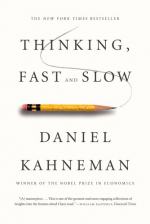
|
| Name: _________________________ | Period: ___________________ |
This test consists of 5 multiple choice questions, 5 short answer questions, and 10 short essay questions.
Multiple Choice Questions
1. What aspect of the mind answers the question: "Does it hurt now" (734)?
(a) The loss-aversive self.
(b) The anchoring self.
(c) The remembering self.
(d) The experiencing self.
2. One of the decision problems that Kahneman and Tversky examined (as discussed in Chapter 25) was whether one would choose a coin toss in which the winner wins $100 or what?
(a) Getting $46 for certain.
(b) Losing $50.
(c) Getting $80 for certain.
(d) Losing $20.
3. Who is the intellectual leader of an association of scholars against the author's works who call themselves NDM's?
(a) Gary Klein.
(b) Malcolm Gladwell.
(c) Danny Oppenheimer.
(d) Baruch Fischhoff.
4. In the following example from Chapter 30, the author posits the following in regards to a person choosing a marble from an urn. The red marbles win a prize. "Urn A contains 10 marbles, of which 1 is red. Urn B contains 100 marbles, of which 8 are red" (631). What are the chances of winning in Urn B?
(a) 16%.
(b) 8%.
(c) 10%.
(d) 20%.
5. When did the CIA obtain information that al-Qaeda might be planning a major attack against the United States?
(a) September 9, 2001.
(b) July 10, 2001.
(c) March 12, 2001.
(d) January 2, 2000.
Short Answer Questions
1. The author asserts that errors of prediction are inevitable for what reason?
2. What term does the author apply to the idea that once you have accepted a theory and used it as a tool in your thinking, it is extremely difficult to notice its flaws?
3. What well-known expert in marital relations estimated that a stable relationship requires good interactions outnumber bad interactions by at least 5 to 1?
4. Who is the author of The Halo Effect?
5. How many pairs of competing companies are analyzed in Built to Last?
Short Essay Questions
1. Why does Kahneman cite the book Expert Political Judgment: How Good Is It? Who wrote this book?
2. What is broad framing? What is narrow framing?
3. How does the author assert terrorism works in Chapter 30?
4. What is the principle of loss aversion?
5. Why does the author credit Virginia Apgar with saving the lives of many infants?
6. What evidence was presented by Ed Diener and his team when examining vacations?
7. What is an illusion of skill?
8. What is flow?
9. What story from Malcolm Gladwell's book Blink does the author present?
10. What is hindsight bias?
|
This section contains 770 words (approx. 3 pages at 300 words per page) |

|




